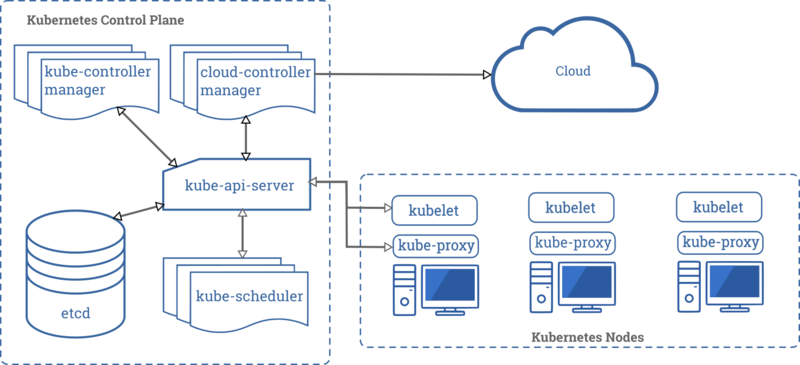Kubernetes
Kubernetes is an open source system for managing containerized applications across multiple hosts. It provides basic mechanisms for deployment, maintenance, and scaling of applications.
It's important to note right up front, before you dive into Kubernetes, that minikube is the tool for local Kubernetes.
Kubernetes Components edit
When you deploy Kubernetes, you get a cluster. The cluster is composed of many components. Here are brief details on some of them.

Kube-apiserver edit
The API server is the front end for the Kubernetes control plane.
The main implementation of a Kubernetes API server is kube-apiserver. kube-apiserver is designed to scale horizontally—that is, it scales by deploying more instances. You can run several instances of kube-apiserver and balance traffic between those instances.
etcd edit
Consistent and highly-available key value store. Used for backing store for all cluster data. https://etcd.io/docs/ Play with etcd. github: https://github.com/etcd-io/etcdlabs Sizing etcdctl (command line client)
Kube-scheduler edit
Control plane component that watches for newly created Pods with no assigned node , and selects a node for them to run on.
Factors taken into account for scheduling decisions include: individual and collective resource requirements, hardware/software/policy constraints, affinity and anti-affinity specifications, data locality, inter-workload interference, and deadlines.
Kube-controller-manager edit
Control Plane component that runs controller processes; including Node controller, Replication controller, Endpoints controller, Service Account and Token controllers.
Cloud-controller-manager edit
A Kubernetes control plane component that embeds cloud-specific control logic. The cloud controller manager lets you link your cluster into your cloud provider's API, and separates out the components that interact with that cloud platform from components that just interact with your cluster.
Node Components edit
Node components run on every node, maintaining running pods and providing the Kubernetes runtime environment.
Kubelet edit
An agent that runs on each node in the cluster. It makes sure that containers are running in a Pod .
Kube-proxy edit
kube-proxy is a network proxy that runs on each node in your cluster, implementing part of the Kubernetes Service concept.
Container runtime edit
The container runtime is the software that is responsible for running containers. Docker by default, it can also be CRI-O or possibly other implementations of the Container Runtime Interface.
Addons edit
You probably need at least the DNS and Web UI addons.
Tools edit
Kubectl edit
The kubectl command line tool lets you control Kubernetes clusters. See Using kubectl to Create a Deployment.
Kubeadm edit
Kubeadm is a component of Kubernetes.
- Kubeadm is a tool built to provide best-practice "fast paths" for creating Kubernetes clusters. It performs the actions necessary to get a minimum viable, secure cluster up and running in a user friendly way. Kubeadm's scope is limited to the local node filesystem and the Kubernetes API, and it is intended to be a composable building block of higher level tools.
Helm edit
Helm (github) is a tool for managing Charts. Charts are packages of pre-configured Kubernetes resources.
Use Helm to:
- Find and use popular software packaged as Helm Charts to run in Kubernetes
- Share your own applications as Helm Charts
- Create reproducible builds of your Kubernetes applications
- Intelligently manage your Kubernetes manifest files
- Manage releases of Helm packages
Container Registries edit
RedHat has a registry at quay.io. Quay builds, analyzes, distributes your container images.
For example, see the bitnami manifest for MediaWiki. What's really interesting is that not only can you quickly look at the manifest, they also show you a list of all the packages built into the image. Most importantly, they do a security scan for vulnerabilities and even show which layer the (vulnerable) package is introduced in.
Chart Repositories edit
There is a Helm chart repository at https://hub.helm.sh/ There you can find the chart for Bitnami MediaWiki
Bitnami has it's own chart repository at https://charts.bitnami.com/ (nothing to see there). The GitHub repo is https://github.com/bitnami/charts
Cloud Providers edit
Each cloud provider has customized their offerings for Kubernetes to integrate with their platforms. So we have:
VMWare Enterprise PKSVMWare Tanzu Kubernetes Grid- Azure Kubernetes Service (AKS)
- Amazon Elastic Container Service for Kubernetes (EKS)
- Google Kubernetes Engine (GKE)
- IBM Cloud Kubernetes Service (IKS)